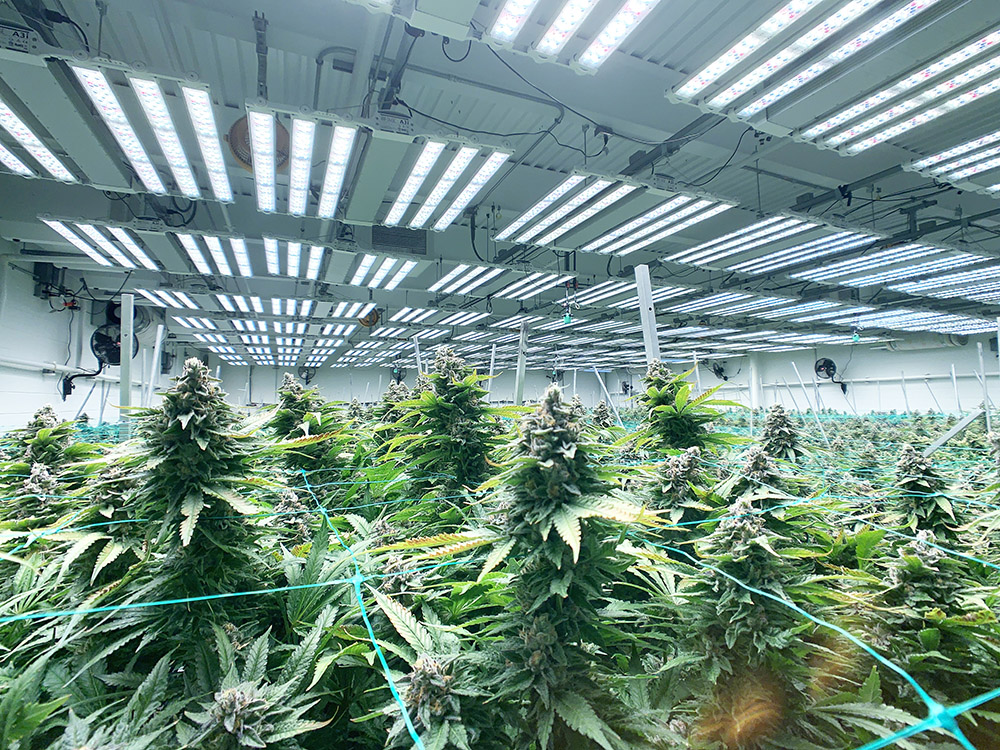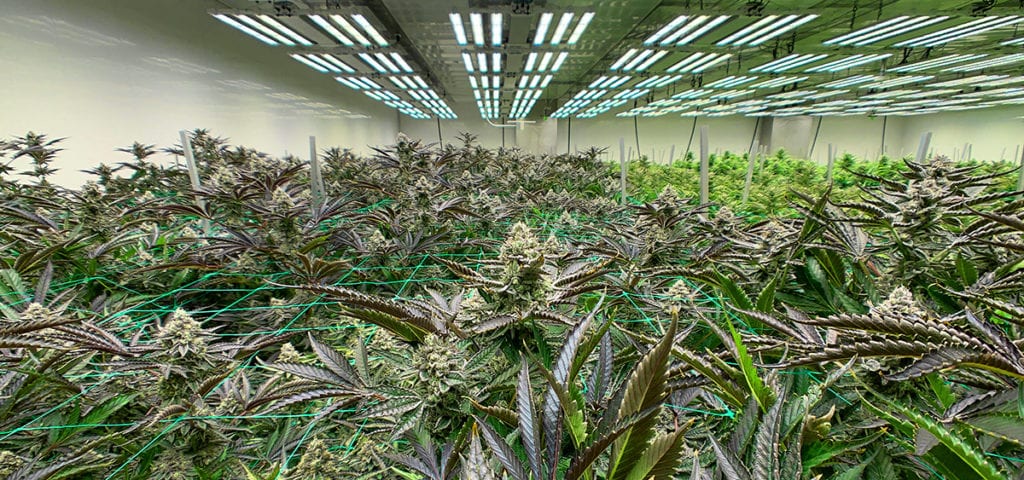Lume Cannabis Company is a vertically integrated, Michigan-based cannabis brand outfitted with a one-of-a-kind cultivation facility and a zealous eye on the retail market. Their company goal is to open 100 retail stores in the state by 2024, and they’re currently on track to succeed. Their LED-powered cultivation facility features patented technology built to scale up alongside their retail footprint to support this growth. The experienced cultivation team studies real data collected from all Lume facilities to adapt and expand successfully.
Lume’s VP of Operations & Director of Cultivation Kevin Kuethe entered the project as a consultant before he came on as one of the first four Lume employees. Lume now employs 500 Michiganders and expects to double that number by the end of 2021. Their focus is on massive growth and crafting the cleanest, most effective flower, concentrates, and edibles. To accomplish this, the Lume team doesn’t cut corners to meet deadlines or save money — they continue to push for the best.
“We are a local Michigan company, and our founders are local Michigan guys,” Kuethe told Ganjapreneur. “The one thing that’s different about Lume is that they’re willing to do whatever it takes, even if it costs more money or takes more time, to do it right.”
In his decade of cannabis cultivation experience throughout the US, Kuethe has built out fourteen different cultivations of all types, from hemp to cannabis and indoor to outdoor. After these myriad experiences, Kuethe swears by the vertical integration approach as the only method for reaching high-profit margins. Lume currently operates a 55,000 square foot indoor cultivation facility featuring ten 3000 sq ft. flowering rooms. They have one remaining room to transition over to Fohse LEDs.

As for their retail presence, the company began with just one store in their initial founding and opened twelve new locations throughout 2020. Over the next year, their aggressive expansion goal is to open 27 more stores in Michigan with no plans to expand outside of state lines.
Lume-branded gummies, pre-rolls, and cartridges feature strain names and effect-based guidance on the labels. This distinction assists the customer as they browse for the perfect product. The company also operates a solvent-free lab that uses whole, fresh frozen flower to produce ice water extracts and live rosin.
To grow their flower, Lume relies on hydroponic systems with rock wool cubes, mixing their nutrients with agricultural-grade salts. Testing goes beyond the final product — during cultivation, every ingredient is sent out for testing, especially if it is going to be used in the nutrient cycle. They also send phenotypes out for petiole leaf analysis to test whether nitrogen, phosphorus, potassium, magnesium, and other minerals are “adequate,” “deficient,” or “excessive” and mix nutrients based on the results.
Kuethe said, “During one of my first cultivations, I realized that nutrients were a major expense, so I educated myself, hired a chemist, and reverse engineered a bunch of nutrients out there… I was able to come up with recipes that outperformed anything I could find on the market. To this day, we mix and measure all of our own stock content nutrient solutions in-house.”
The Lume cultivation was designed with a team of process engineers, who hold relevant patents dealing with humidity, temperature, air, and space control. Kuethe and the engineers used their combined experience and said patented systems to create a grow space that doesn’t exist anywhere else. They considered the environmental control strategies by learning about how cannabis grows and about vapor pressure deficits, transpiration rates, water, and critical airflow. As a result, their system dehumidifies and tempers the air, pumping it into rooms. The airflow quantifies at 30k CFMs without using fans, facilitating a full air change every 60 seconds.
In their first year of operation, Kuethe became interested in transitioning to LED lighting systems, testing 13 different options against his HPS systems before finally finding Fohse LEDs. Before working with Fohse, he noticed his lower canopy was a bit larfy, indicating that the LEDs had low light penetration and poor photo density. However, using just one Fohse light, the veteran grower saw an improvement in his plants. With those results he switched over an entire flowering room, unlocking the real power of the Fohse A3is.
“The Fohse A3i does amazing things. Any good commercial grower could put that light over their canopy, and they would see the difference in the first run if they just swapped out one light from HPS and saw them side-by-side, it would speak for itself. That’s what I did, and now I’m slowly swapping out my entire facility, and that’s hundreds of hundreds of lights,” Kuethe said.
Every week, the Lume cultivation team collects data from their flowering rooms, allowing them to compare how much moisture is being removed at which time, the volume of moisture coming out with the wind or airspeed, and transpiration points to growth stages of the plants. This information opens up a new world of analysis for learning how the cannabis plant works.
Once he had an entire room of Fohse lights operating, Kuethe said the numbers spoke for themselves. In some genetics, Kuethe has seen as much as a 10% THC increase and a 40% yield increase after switching over from HPS to LEDs. He added that this isn’t true for absolutely every strain; however, he has never seen plants decrease yield size or quality after switching over. He is proud of the wet: dry weight ratio of 19%, which topples the 12-15% dry weight ratio of other talented large-scale commercial growers. Aside from the LEDs, Kuethe credits these numbers to choices they’ve made based on raw data.
For best results, cultivation teams need to prepare their environmental controls when transitioning to Fohse LEDs to see those exponential results. Luckily the Lume custom-engineered cultivation brings all environmental controls into one brain unit, allowing them to change or add anything. Kuethe noticed that his plants were growing larger and more robust under Fohse lights, which naturally led to more transpiration. After monitoring the changes, he upped the watering schedule and focused on humidity changes. The new transpiration rate was probably due to the exponentially lower heat put off by Fohse LEDs. The output of heat from HPS systems can create terpene degradation, lowering the quality of the dried and cured flower.
“A lot of people don’t realize how heat-volatile terpenes are. It’s such a drastic heat source; the high-pressure sodium (HPS) put off hundreds and hundreds of degrees temperature, and they’re only three or four feet away from your canopy. Whereas the LED Fohse fixture you can touch with your hands, so you know that you’re preserving all of these terpenes, your quality is going up, a lot is going on besides just the energy and cost savings.” Kuethe said.
Going forward, Lume will continue to grow, manufacture, and sell its suite of products in the state of Michigan. They are building out a million-dollar R&D room to continue using data to adapt their brand to the market environment. In the new research area, they will have a tissue culture lab that opens up the worlds of plant sexing, genotyping, tissue cultures, micropropagation, and more. They are also building an 85,000 sq ft expansion to their cultivation, with plans for 30 acres of outdoor and four tunnel greenhouses soon.
Their product development team, meanwhile, continues to innovate their product line, most recently making a hash roll where kief is pressed into paper on a rosin press and used to roll a joint. The hash roll is attached to a glass tip and smoked down slowly. The team is also maximizing efficiency, with recent additions of a 20,000-per-day gummy machine and a rolling machine that can put out 2,400 rolled, weighed, and twisted joints in one run.
“Technology never stops, and when you’re in a new industry like cannabis, the rate at which technology is developed is so rapid that just sticking to one thing that works for you might work for the time being but it’s going to be hard to compete in a commercial setting with that mindset. That has driven the way my facilities are set up,” said Kuethe.
Above all else, Kuethe is hugely proud of their work at Lume. He honors the ten-year path that finally landed him at a facility where he can study the cannabis plant in-depth. With this highly engineered space and the Fohse LED lighting systems, he has proven their concept. Due to automation, every harvest has continued to be their largest yield, highest quality, and most efficient growth rate, yet. Their cost per pound is almost cut in half. These systems, automation, and dedication to adapting enable Lume Cannabis Company to scale up to match their aggressive push to retail growth in their state.
